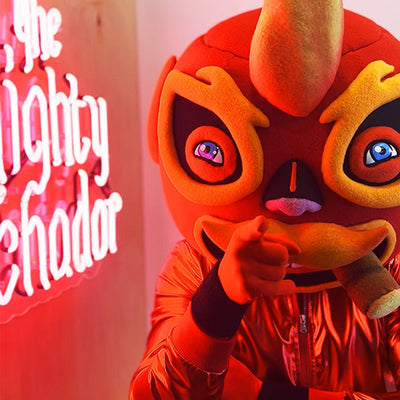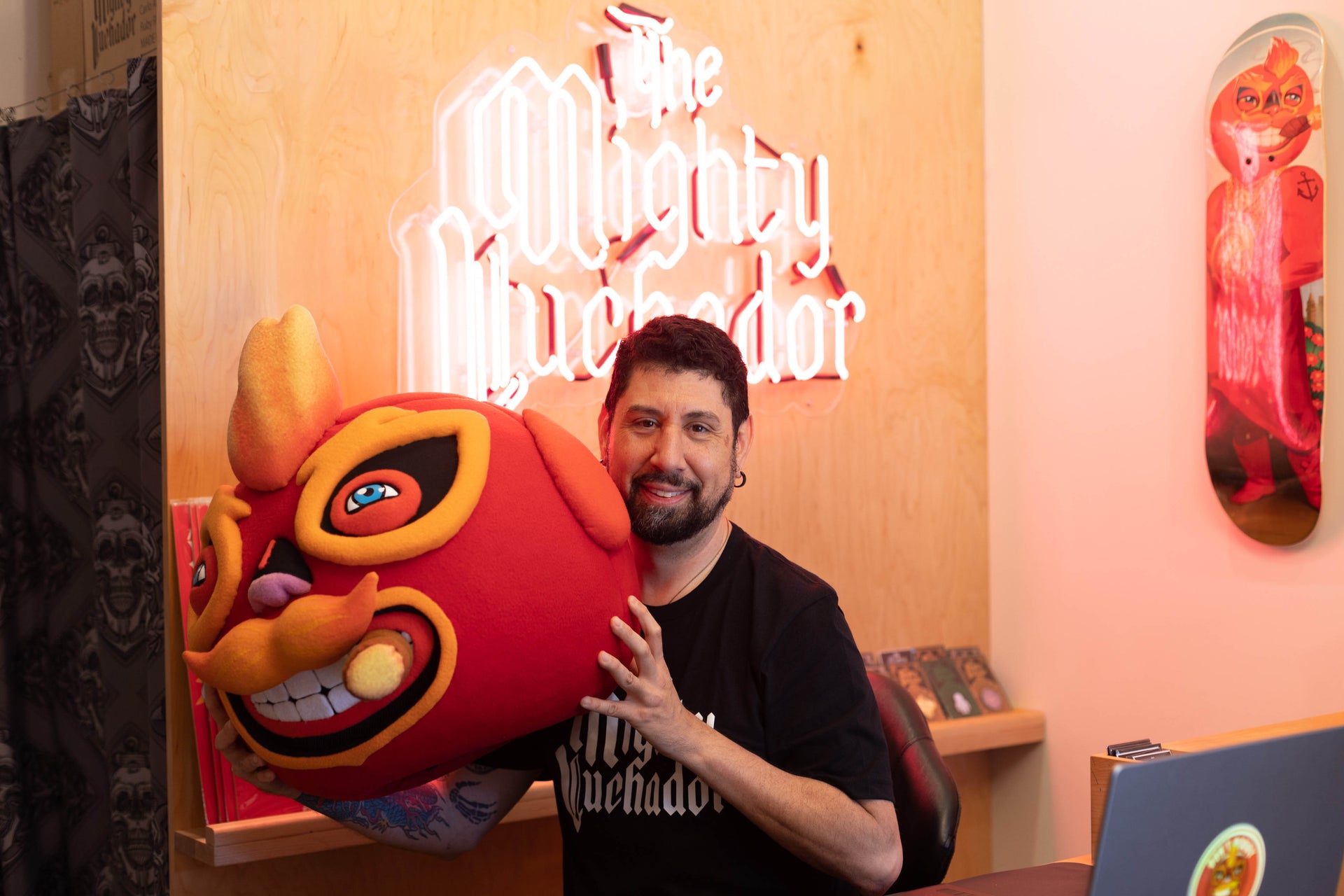Written by Agustín Cruz
Photos by Julie Leopo and Carlo Flores
De Los, the Latinx-focused platform of the Los Angeles Times, has launched 101 Places to Experience the Best of Latino Los Angeles. The Mighty Luchador is featured on the inaugural list alongside 100 amazing places, and we are proud to be in such great company especially considering that third places (terceros espacios) have been disappearing. The third place is a place outside the first place (home) and the second place (work), where people hangout together. Now, more than ever, we need those third places—spaces where we can be in community with each other, exchange ideas, organize, mobilize, provide mutual aid for each other, and engage in radical joy and self-care. There is a long history of Chicane/o and Latine/o communities forging important sites like these in Los Angeles. In the neighborhood of Highland Park alone, there used to be three important third places: Regeneración: Public Resource Center, MeChicano Art Center, and Centro de Arte Publico, however, these three places no longer exist in those physical spaces today. The apparitions of these third spaces may serve as rēcords of gentrification and a sustained attack on the arts.

Photo by Carlo Flores.
While these forces continue to push Chicanes and Latines out to the margins, Carlo Flores took up space in Eagle Rock where he founded The Mighty Luchador. There, he combines his love of the Mexican lucha tradition, comics, collectible toys, and art with his personal journey of continuing to deepen his rēlationship with his Chicane consciousness and queer identity. The Mighty Luchador features Chicane and Latine artists, with special focus on folks from the borderlands and Latin America. The Mighty Luchador dedicates shelves and wall space to art that speaks to identity and migration, while there is a concerted effort to dispossess us. Carlo also engages artists in collaborations, and displays the works (art/ifacts) with great care and reverence. The artists at The Mighty Luchador are akin to tlacuilos (Mesoamerican artist-scribes), some work in toy design and 3D modeling, while others focus on painting or graphic design, however, all of the artists at The Mighty Luchador are storytellers. Their works function, much like the Mesoamerican codices, to rēcord our ontologies in the face of colonialism and epistemicide. Martha Ibañez-Baldor of De Los edited this year’s 101 list, she wrote, "Some of our favorite stories are those that delve into how Latinos are carving their own path and creating spaces for their communities[.]" In a similar vein (and borrowing from Gloria Anzaldúa and Robin D.G. Kelley), Carlo is drawn to artists whose works speak to the rēalities of Nepantlerxs—those who dwell in the borderlands, whose art/work transports us to another place and time, inspiring us to imagine a more just world that does not exist yet.
Some of the tlacuilos that The Mighty Luchador carves out space for are Kayden Phoenix, a queer Chicana graphic novelist and filmmaker from Boyle Heights; Los Fokos (Alex Fuentes), a self-taught Chicano artist-chameleon from Los Angeles, Frankmysterio, a prolific and iconic Mexico City artist and toy designer whose work embodies Mesoamerican visual culture; Kraven Comics, Latinx publishers of a queer superhero comic book series; and Emmanuel Valtierra, a Mexican codex artist (tlacuilo) in San Antonio, Texas.

Photo by Carlo Flores.
Kayden Phoenix created the first Latina superhero team in a graphic novel series titled A La Brava. The series begins with Jalisco, a young ballet folklorico dancer in search of her disappeared mother. She joins a group of underground Adelitas and becomes a Latina superhero that uses her culture to fight against femicide. The next installment centers on Santa, a social justice warrior from the imagined bordertown, Wexo, Texas. She comes into her superpowers by raiding detention centers at the border and taking down a political villain named Illena Chavez Estevez (known by the acronym, ICE). Ruca begins with the titular character boarding an LA Metro bus in Highland Park, where she lives. She takes the bus to East L.A.’s Whittier Blvd. only to find that it has been gentrified seemingly overnight. Eventually, she meets an activist group akin to Gloria Anzaldúa’s artivistas, and they fill her in on a child trafficking ring that is responsible for the kidnapping of children. Ruca heads to Barrio Logan in San Diego to rescue the stolen children. Bandita is a Dominicana gun-slinging cowgirl from The South living in New York. The brave and fearless Bandita tackles domestic, intimate partner, and gender violence in this novel. For a younger audience, Kayden has created the Princess Academia series. The series opens with Mexica, the princess of Aztlán who embarks on a rite of passage. The titular novel, Princess Academia takes place at a prestigious boarding school for princesses from all parts of the galaxy. They must work together to deal with hauntings and a curse at their school.
Los Fokos is the penname of Alejandro Fuentes. Born and raised in L.A., Fuentes moved to Silver Lake in 1983 at age 8, well before gentrification changed the DNA of the neighborhood. His family ended up in Silver Lake because his mom was left to raise Fuentes and his siblings on her own—Silver Lake was an affordable neighborhood back then. Fuentes often has flashbacks of witnessing scenes of violence and addiction. In his adult life, he makes sense of his childhood by combining his memories with art, sometimes using only images, and other times combining images with words. His work is at once dark and vibrant, spiritual and irreverent. I rēsonate with his graphic novel, Wiggy83 (preview), about a little anthropomorphic parrot kid who is freaked out by some things he encounters on the street and thinks about running away. I had a similar experience growing up in Southern California in the 90s during Prop 187, and I rēmember having a recurring dream of flying away to a different place. Wiggy83 also rēminds me of one of my favorite stories, Parrots: A Parable by Walther Thompson-Hernández. I especially appreciate the way Wiggy83 and Parrots blend the oneoiric with the memorial to rēproduce nostalgia and momentos. In describing the concept of Wiggy83, Fuentes writes, “It is in no way a social statement. It’s simply a memory…If you’re smart, or just lucky, you find the little things in life that you form into therapy tools.”

Photo by Julie Leopo
There is a beautiful display case at the center of the shop where we showcase unique art/ifacts behind glass, and RGB lights illuminate the art/ifacts. There, you’ll find Frankmysterio’s pieces. Frankmysterio works in the sofubi style, which originated in Japan and often features monsters, robots, and figures inspired by Japanese culture, with a focus on handcrafted, limited-release pieces. Frankmysterio lives in Mexico City and his brand of sofubi incorporates Mexican culture and Mesoamerican mythology, like his Mictlan piece (pictured below). Kraven Comics published the comic book series titled Class6. Fernando Velez created the comic in which six LGBTQ superheroes work together to protect vulnerable queer people. Class6 comic books are sold exclusively in-store. Emmanuel Valtierra is a San Antonio-based tlacuilo/artist who works in the style of the Mesoamerican codices. The Mighty Luchador carries his luchador playing card decks (available on our site) and Aztec tarot deck (only sold in-store).

Photo by Julie Leopo
We take great pride in providing a physical space for these important and beautiful works—that document our culture and history—to exist, even in the face of mass deportations, family separations, and gentrification. We are working on making The Mighty Luchador a space that serves our intersecting communities in various ways. We are in the planning stages of a luchador film screening series, planning a calendar of in-store events like book signings and meet-and-greets, and we hope to cultivate a space that brings people together, to have in-person conversations and exchange ideas, thoughts, aspirations, dreams, and memories. We invite you to come by and visit us, have a look around without feeling pressure to purchase anything. Our team consists of Carlo and Agustín (me). We’d love to get to know you and hear about how The Mighty Luchador can better serve you.

Photo by Julie Leopo
Notes:
- "Regeneración: Public Resource Center," pbssocal.org/shows/departures/regeneracion-public-resource-center
- "Regeneración: Three Generations of Revolutionary Ideology," vincentpriceartmuseum.org/exhibitions_regeneracion.html
- "MeChicano Art Center," pbssocal.org/shows/departures/mechicano-art-center
- "Centro De Arte Publico," pbssocal.org/shows/departures/centro-de-arte-publico
- "Two Highland Park Chicano Spaces Just Became LA Monuments, " laist.com/news/arts-and-entertainment/two-highland-park-spaces-that-were-part-of-the-chicano-movement-become-l-a-historic-cultural-monuments
- "Former Highland Park Chicano Art Centers Recommended as Cultural Monuments," theeastsiderla.com/neighborhoods/highland_park/former-highland-park-chicano-art-centers-recommended-as-cultural-monuments/article_83d6e3cc-5c29-11eb-97f7-af69656518ee.html
- "Remembering the Chicano Arts Collectives of Highland Park," latimes.com/local/la-xpm-2012-jan-14-la-me-highland-park-art-20120114-story.html
- "Corazon Productions: A Chicano Collective," pbssocal.org/shows/departures/corazon-productions-a-chicano-collective


